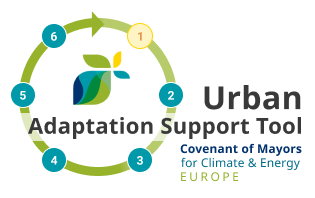
Preparing the ground for adaptation
1.1 Obtaining political support for adaptation
High-level political support for adaptation in a city is a prerequisite for successful implementation of adaptation actions. Adaptation to climate change may not be high on the political agenda due to other pressures being perceived as more urgent, a lack of awareness about adaptation, negative connotations linked to the terms "climate change" or "risks", or the mismatch in short-term budgetary cycles and legislative periods and the long-term and future nature of climate change impacts and risks. Thus, securing political support is essential to give more prominence to adaptation.
A political commitment to climate change adaptation agreed by the local council and signed by the mayor, such as signing the Covenant of Mayors, can be an important first step towards political buy-in.
High-level political support can be brought about through several triggering factors.
In February 2021, the European Commission adopted the Communication ‘Forging a climate-resilient Europe – the new EU Strategy on Adaptation to Climate Change’. The Strategy outlines a long-term vision for the EU to become a climate-resilient society, fully adapted to the unavoidable impacts of climate change by 2050. This strategy aims to reinforce the adaptive capacity of the EU and the world and minimise vulnerability to the impacts of climate change, in line with the Paris Agreement and the proposal for a European Climate Law. The Strategy aims to build a climate resilient society by improving knowledge of climate impacts and adaptation solutions; by stepping up adaptation planning and climate risk assessments; by accelerating adaptation action; and by helping to strengthen climate resilience globally. It pursues three objectives of achieving smarter, more systematic and faster adaptation.
Such top-down recommendations and legal requirements from the supra-national and national level are among the frequent triggers for action on adaptation. National adaptation strategies may require that municipalities develop their local level strategies and provide them with support for fulfilling this task, including financing mechanisms. The adoption of the new Adaptation Strategy creates a very favourable political situation for adaptation, as it ensures high-level political support and recognition for adaptation actions at all levels of governance. See Chapter 4: Multi-level governance of urban adaptation in Europe of Urban adaptation in Europe: how cities and towns respond to climate change.
The new Adaptation Strategy introduces a relatively new aspect - achieving resilience in a just and fair way, so that the benefits of climate adaptation are widely and equitably shared. It recognises that European regions and citizens are directly affected by climate change, for example through job losses in climate-affected sectors such as agriculture, fisheries, and tourism, and that unequal exposure and vulnerability to climate impacts of different regions and socio-economic groups worsens pre-existing inequalities and vulnerabilities.
Legal obligations can also originate from sectoral policies. In the framework of the Urban Agenda for the EU, a series of trainings for politicians on adaptation took place. Their purpose is to provide information to politicians to familiarise them with the subject and assist them in their decision-making on issues related to adaptation.
In situations where there is no top-down mandate from political decision-makers or senior public management (which goes beyond the legislative period), other triggers are likely required such as bottom-up pressure from aware and initiative-ready constituencies, experience of climate-related natural disasters, or high popularity and frequency of discourse on climate change risks and adaptation in public and political circles on various levels. See Chapter 5 of the EEA report Urban adaptation in Europe: how cities and towns respond to climate change, which takes stock of adaptation planning and action at the local level in Europe.
To strengthen the case for adaptation in the absence of top-down requirements, administrators who would like to initiate adaptation action and win high-level political support can consider the following actions:
- Collect evidence and knowledge on climate change risks and on benefits of adaptation to make a convincing ‘adaptation case’ (see e.g. guidance from the RESIN project on development of a business case for adaptation);
- Liaise with stakeholders who have stakes in climate-sensitive sectors, including initial awareness raising among them (see Step 1.6);
- Develop concrete ideas of how adaptation action could be carried out (see also Step 3.1);
- Use the momentum of incidences of extreme weather events and exposure to other climate change risks (see Step 2.1);
- Consider alternative policy lines that can be bundled with adaptation, such as sustainable development, spatial planning, disaster risk management, etc., and the positive synergies and spill-overs (see Step 2.6);
- Develop and use communication messages that correspond to the current policy priorities or aims (See Step 1.7);
- Use the experiences of other cities and similar areas as examples of adaptation benefits;
- Collect information on available adaptation funding, thus lessening the hurdle of decision-makers to find additional funding for adaptation action (see Step 1.5).
Political support can be sustained through long-term policy documents or participation in regional, national or international adaptation initiatives.
